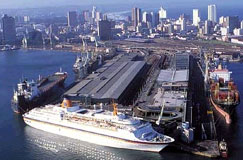South Africa scores for global integration
1 December 2014
South Africa's economy is more connected to the global economy than its peers in the
rest of sub-Saharan Africa, according to the Visa Africa Integration Index.
The country scored the highest on the index, improving from 61.1 at the start of 2011 to
66.7 at the end of 2013.
The index tracks 11 countries divided into key country clusters in sub-Saharan Africa,
revealing strengths and areas of growth potential. The clusters are:
- West Africa: Ghana and Nigeria
- East Africa: Kenya, Uganda, Rwanda and Tanzania
- Southern Africa: South Africa, Angola, Mozambique, Zimbabwe and Zambia
The 11 constituent countries are highly representative of the region, with a combined
population of 437 million people, or 55% of the total population.
South Africa scored highest amongst the 11 countries for global integration with a score
of 42.6 out of 50. Kenya scored highest for regional
integration, scoring 27.5 out of 50,
narrowly overtaking Ghana. But all 11 countries were a long way off the global median
of 50.
Visa in South Africa launched the second annual Visa Africa Integration Index on
Tuesday, 25 November. It measures the degree of economic integration within key trade
corridors of sub-Saharan Africa, namely West Africa, East Africa and Southern Africa.
Data
The purpose of the index is to better understand and to help facilitate economic growth
from greater cross-border interaction and economic openness.
Mandy Lamb, the country manager of Visa South Africa, said: "Since the launch of the
Visa Africa Integration Index in 2013 the African economy has extended its best period
of economic growth on record by delivering growth of 4.8% in 2013.
"Our objective was to construct an index for a number of selected sub-Saharan African
countries to measure their global and regional integration. The index is
built from
country-level macroeconomic data and a wealth of proprietary data.
"The final outputs are economic integration scores at the country and regional levels
measured on a semi-annual basis for the period 2011 to 2013," Lamb said.
Buoyant
Lamb noted that it was widely expected that buoyant economic growth would continue
for the foreseeable future and it was likely that the African economy would achieve a
growth rate approaching 5.5% in 2014, with a collective gross domestic product of over
$1.9-trillion – a figure that is expected to exceed $2.6-trillion by 2020.
The study was carried out in conjunction with Prof Adrian Saville, visiting professor of
economics at the Gordon Institute of Business Science (GIBS) in Johannesburg, and Dr
Lyal White, director of the Centre for Dynamic Markets and a senior lecturer at GIBS.
Four key metrics to measure integration were used: the flow of goods and services or
trade, financial
integration and the movement of capital, the flow of information and
knowledge, and the movement of people. This model assigned a numeric value to the
level of integration, with the global median score being 100.
Findings
Despite a modest base, the countries surveyed have undergone positive structural
transformation over the past decade. All 11 countries showed improvements in
economic integration.
In some cases the improvements were modest: Zimbabwe and Uganda recorded gains
in integration that amount to 0.5% a year and 1.2% a year, respectively. In other cases
the gains were swift and substantial. Rwanda’s index score rose by just less than 20%
over the three years. Angola, Ghana, Kenya, Nigeria, South Africa and Zambia all
recorded robust single-digit improvements in economic integration.
The analysis also considered the depth and breadth of integration, and how integrated
each country was globally and regionally. In terms of
"depth", a country is considered to
be "deeply integrated" if the economy is particularly open and highly connected to the
rest of the world. Integration only becomes "deep and broad" if a highly connected
economy is engaged with a wide variety of counter parties across the different strands
of its global relationships.
Structural improvements
While South Africa scored highest for global depth (48.3 against the global median of
50) and global breadth (36.9); Mozambique scored highest for regional depth (27.3);
and Kenya had the highest score for regional breadth (40.9).
Notably, none of these scores achieved the global median of 50, pointing to the need for
further structural improvements.
"Findings around openness and increased integration have important implications for the
socio-economic advance of African economies based on at least two structural drivers,"
said Lamb. "Firstly, African economies are substantially unconnected
to the rest of the
world. Secondly, African economies largely are unconnected to each other.
"Africa stands to gain from a sustained structural benefit brought about by the opening
up of African economies to each other and to the world at large."
Source: Visa
 Durban Harbour, the largest port on the continent and a major gateway to Africa (Photo: Ethekwini Online)
Durban Harbour, the largest port on the continent and a major gateway to Africa (Photo: Ethekwini Online)




